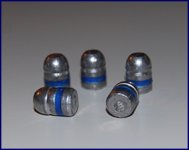I reload 125 gr lead FNRP bullets for CAS in .38 Spl and the bullets themselves always have a wax or greasy coating on them.
What is it?
What purpose does it serve?
My loaded rounds seem to load in the gun(mag tube) easier if I wipe it all off but I am not sure if it serves a purpose or not.
Also would like to know if its ok to crimp on the grease ring?
Thank you
What is it?
What purpose does it serve?
My loaded rounds seem to load in the gun(mag tube) easier if I wipe it all off but I am not sure if it serves a purpose or not.
Also would like to know if its ok to crimp on the grease ring?
Thank you

